
In the rustic realm of art, where strokes on canvas breathe life into silent scenes, Jean-François Millet's "Woman with a Rake" invites us to witness a tranquil vignette of human existence entwined with the earth. A lone woman, stooped in labor, guides a rake through the soil, embodying the essence of an agricultural symbiosis. Millet's brush captures the simplicity of rural life, portraying a harmonious coexistence between the toiling figure and the fertile land.
Parallel to this visual narrative, Scott Momaday, in his literary tapestry "First American Views," unfolds a tale of contrasting landscapes — one woven by the hands of Native Americans in concert with the earth, the other scarred by modern America's voracious exploitation. Momaday articulates the profound connection indigenous people share with the land, a relationship grounded in love and reciprocity. He traces the trajectory of America's evolution, lamenting the departure from a once-nurturing harmony with nature to an era of environmental degradation.
The common theme echoing through these diverse artistic expressions is the ethos of living in consonance with the land. Millet's canvas freezes a moment where the rhythmic cadence of the rake mirrors the pulse of a community working hand in hand with nature. Momaday, wielding the pen as his brush, sketches a larger panorama, urging a return to the indigenous ethos of cooperative existence with the earth.
Millet's art and Momaday's prose converge on the notion that harmony with the land is not a fleeting idyll but a sustainable way of life. Millet's painting immortalizes a snapshot of this communion, while Momaday, in his narrative, serves as a herald, calling for a collective return to the wisdom of indigenous cultures. Together, these works beckon us to embrace a narrative of harmony, where humanity and the land dance in a timeless choreography of mutual respect and coexistence.